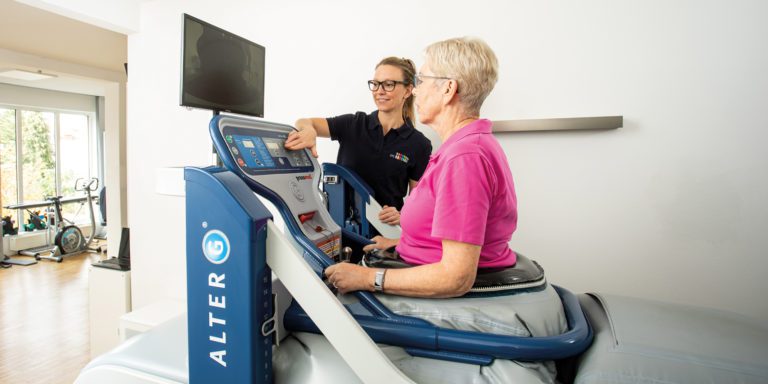The AlterG is a treadmill that allows virtually natural running under reduced gravity using differential air pressure technology. The user wears special neoprene shorts during training and is lifted by increased pressure, which allows body weight to be reduced by up to 80% in increments of 1%.
This means that at the final setting someone weighing 75 kg is exposed to loads equivalent to 15 kg. What is particularly noteworthy is that gait and even running hardly differ from natural movement patterns at high speeds. This is a very significant and valuable difference from other forms of weight-reduced running, e.g. running in water or using harnesses or crutches.
Use at the ZfS Münster
The AlterG anti-gravity treadmill first came into operation at the ZfS Centre for Sports Medicine in Münster on 01/10/2015 and has been used daily for the treatment of patients with a wide variety of indications ever since. Physiotherapeutic support is provided at the ZfS, i.e. a physiotherapist gives the patients initial instruction and guidance for training and is also present throughout the training session (essentially, 1 to 1 treatment). The treadmill first became known in the early 2010s through its use in elite sports. This also led us to focus initially at the ZfS on indications for the rehabilitation of competitive athletes and aspiring recreational athletes. In addition to its use in the rehabilitation of injured or operated athletes, this included runners, who were interested by the anti-gravity treadmill, as it can be set to speeds from 0 to 19 km/h and even to different gradients. This allows runners with injuries or repetitive strain damage to continue to train with incentive and helps prevent or at least reduce any fall-off in performance. Studies by the developers of the AlterG show that if the speed of the treadmill is increased during running training/running by approx. 0.96 km/h for each 10 % reduction in body weight, metabolic stress remains more or less the same.
Our own experience
With increasing experience, it became clear that the options for use with this new therapy equipment go far beyond the accelerated rehabilitation and gentle joint and tendon training of elite athletes. It has also been interesting for non-athletes of all ages following injury or surgery. The treadmill opens up unknown opportunities for getting back on one’s feet, particularly after hip or knee surgery, with virtually no loading involved. Due to the precision with which patients can be unweighted, it allows the early mobilisation of freshly injured or operated patients and thus significantly shortens the time they are unfit to return to work/competition. The positive results of long-term studies following the integration of the AlterG into rehabilitation are consistent with our own experience (cf. Palke et al. 2022). Some advantages over rehabilitation in water have been shown in relation to gait and running-oriented rehabilitation. Unlike running in water, no resistance needs to be overcome. Therapy can also start substantially earlier, as in water the risk of wounds becoming infected with microorganisms in the water must first be excluded. The training creates new opportunities especially for osteoarthritis sufferers. For many people with osteoarthritis, being able to walk or run without pain is an almost impossible dream. The reduced loading on the treadmill allows many osteoarthritis sufferers not only to walk but even to perform training runs.
The therapy equipment is also being increasingly used in patients with neurological disorders such as stroke patients and patients with Parkinson’s disease or craniocerebral trauma. For these patients, it is helpful to carry out walking and running movements with virtually no loading, thus allowing them to gradually restore their natural gait. Running movements are recorded by a set of cameras, and patients can follow and correct their running movements via a monitor. During the training, the treating doctor and physiotherapist can first diagnose any walking and running deviations on the monitor and then directly show them to the patients while they are training. In this way corrections can be made immediately. This direct feedback while training allows patients to reduce even habitual or complex gait and running disturbances that could not be addressed with traditional gait training.
Indications
- following sports injuries and/or repetitive strain damage
- surgery of the lower extremities, e.g. hip or knee surgery
- osteoarthritis
- degenerative lumbar spine syndrome
- overweight
- neurological disorders
- gait or running disturbances
- arteriosclerotic changes in the legs
- impaired lymphatic drainage
- beginners and former athletes returning to sports
- elderly athletes who want to be able to run
HOW IS THE TREATMENT INVOICED?
We conduct training on the AlterG as a single physiotherapy session. As supplementary strengthening exercises are usually performed on training equipment and the training is integrated into an overall concept, it is considered a physiotherapy service and is invoiced in accordance with our price list for physiotherapy services. Of course, the price could also be calculated in the same way as a fitness studio subscription or a 10-session ticket.
What is the setting for practical routine use?
- Two treatments a week (from the perspective of science-based training, three sessions would also be meaningful; ideally, there should be a break of one day between each training session)
- One treatment series comprises ten sessions to begin with
- The pure training time per session is usually approx. 20 min (in combination with blood flow reduction training [BFR]); other loading times, e.g. 5 x 1 minute intensive training
- In combination with strength, mobility and coordination training
- Especially for neurological patients, the evaluation of gait via a 3-camera system and combined with medical gymnastic (physiotherapy) on a neurophysiological basis
The future and patient examples
The AlterG will no doubt continue to be a wonderful adjunct to the treatment of athletes in the future. However, elderly patients with osteoarthritis of the knee or imminent (or actual) loss of the ability to walk might also be a patient group that benefit to an even greater extent from this training in the future. To date, there has been little targeted focus on these groups. See also the guidelines for osteoarthritis of the knee, 5.2.1. (Treadmill training with body-weight support improves walking speed and reduces pain). Another alternative treatment mentioned is aquatic training (recommendation 5.1.1), which results in significantly greater pain reduction than land-based training.
Example patient 1: 54 years old, osteoarthritis of the knee, affinity for sports. Any form of running training under normal gravity conditions results in knee pain/joint effusion. The previously well-developed leg muscles have atrophied significantly in recent years. The patient has not run fast for 10 years. The opportunity to do so again would act as a powerful incentive to train.
Example patient 2:74 years old, mild obesity, marked sarcopenia/dynapenia, maximum walking distance has shortened from approx. 200 m to 1 – 2 m now in the last 4 years. The patient is no longer able to go upstairs and now uses a wheeled walker even for short distances. Due to osteoarthritis of the shoulder, the patient avoids distances of more than 10 m. His family fear that he will soon lose the ability to walk completely.
More than normal strength training?
The transfer to everyday walking and running is higher, as anti-gravity training is much more similar to the target activity in terms of movement speed, intramuscular coordination, intermuscular coordination, sensory motor activity than, for example, strengthening of the quadriceps on a leg curl machine. The combination of targeted strength training with the AlterG training is ideal. An important factor in itself is that the AlterG training is fun for most patients. The recurring experience of running without pain is also a significant success factor in our personal view, as this experience generates confidence and pleasure in walking/running, also when not training. For some patients, this positive experience has an almost euphoric effect.
Further ideas – new treatment and training incentives
We have been experimenting with this equipment at the ZfS for several years and combining it with other treatment measures. More recently, we have combined it with BFR training. The aim is to develop hypertrophic muscle effects during the AlterG training. Our initial experiences have been positive and we consider this approach to be highly interesting. However, due to the lack of a CE certification for BFR training equipment such as AirBands, we have so far refrained from integrating these measures into our standard procedures. The training allows patients even with severe osteoarthritis of the knee to run at very high speeds. The high movement speed in particular has surprising therapeutic effects. When combined with BFR training, it also has a good hypertrophic effect. There is a very marked difference between this training and the patients‘ everyday weight-bearing as well as the therapy incentives that have been previously used in most physiotherapy practices. This training thus provides a far greater incentive to train.
Fast running is a very appealing training incentive particularly for athletes over the age of 45. Study results are consistent with our experience that the attainable running speed at 80% partial loading is approx. 20 % higher, and at 60 % partial loading is even 30 % higher. The high running speeds act as a “new“ training incentive for the person training , which is thrilling particularly for older people. This training is also interesting in terms of the typical marked leg muscle atrophy associated with ageing, which affects type II fibres much more than type I fibres. Fast running is also a valuable training aid in this respect.
WARNING: Impact forces that arise during running on the treadmill are determined not only by the reduced weight-bearing set on the AlterG but also, of course, by the speed. This is one of the reasons why we conduct this training at the ZfS only with operated and injured patients in a one-to-one physiotherapy session. A study on tibial impact acceleration peaks in 2019 showed, for example, that impact forces for the tibia are determined by running speed in particular. If this is not taken into account, there is a risk of overload. For example, a patient for whom the surgeon has currently planned 50 % partial weight-bearing, can go on the AlterG at a 50 % setting. If I let this patient run at 15 km/h with 50 %, for example, the resulting impact forces would be far too high.
Autoren
ist Facharzt für Orthopädie mit Zusatzbezeichnungen Sportmedizin, Chirotherapie/Manuelle Medizin, Akupunktur sowie Naturheilverfahren und hat einen Magister in Sportwissenschaft (M.A.) sowie ein Diplom Osteopathische Medizin (D.O.M.). Er hat 2007 gemeinsam mit Dr. Ralph Schomaker das ZfS-Zentrum für Sportmedizin in Münster gegründet (interdisziplinäres Zentrum mit verschiedenen Facharztdisziplinen, Physiotherapeuten, Sportwissenschaftlern und Ökotrophologen). Außerdem ist Dr. Borgmann Verbandsarzt des Deutschen Leichtathletik Verbandes (DLV).




